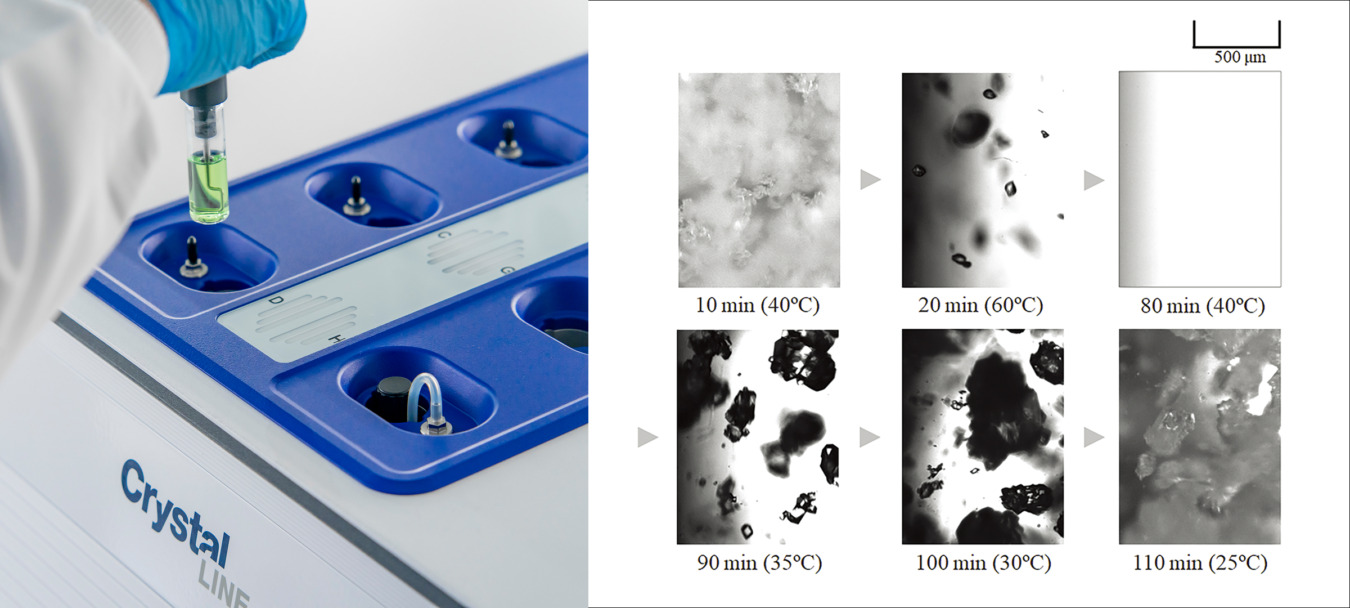Introduction
Crystallization is a critical process in pharmaceutical manufacturing. It determines the quality and characteristics of active pharmaceutical ingredients (APIs), especially their polymorphic forms.
We are excited to spotlight a recent study carried out by a team of researchers at Meiji Pharmaceutical University in Tokyo. This study presents a method for real-time, in-situ monitoring of crystal polymorph transitions of carbamazepine (CBZ), using low-frequency (LF) Raman spectroscopy integrated with the Crystalline instrument.
Two polymorphs, CBZ I (metastable) and CBZ III (stable), were analyzed during dissolution and crystallization. The results showed strong correlations with the visual particle data obtained via Crystalline, a process analytical technology tool used for real-time observation.
Experimental method
Carbamazepine (CBZ) with the stable polymorph CBZ III was obtained commercially, while the metastable CBZ I was prepared by heating CBZ III at 170°C for 1 hour. Suspensions were prepared using methanol as the solvent. In-situ monitoring of the dissolution and crystallization process was conducted using the Crystalline system integrated with a THz-Raman probe and ALL-IN-ONE Raman spectrometer. A suspension containing 500 mg of CBZ I in 3.5 mL methanol was subjected to a temperature cycle: heated from 20°C to 60°C at 2°C/min, held for 20 minutes, then cooled to 20°C at −0.5°C/min. LF Raman spectra were recorded every 120 seconds, and particle view images were captured every 5 minutes.
Results and discussion
The low-frequency (LF) Raman spectra successfully tracked the polymorphic transitions of CBZ in suspension. Upon heating, the spectral peaks corresponding to CBZ I (notably at ~24, 70, and 109–118 cm⁻¹) gradually diminished, indicating dissolution of the metastable form. As the temperature decreased during the cooling phase, peaks unique to CBZ III (at ~35 and 105 cm⁻¹) became prominent, confirming crystallization of the stable polymorph, as shown in Figure 1.

Figure 1: In situ Raman monitoring of dissolution and crystallization processes
Quantitative results from Raman spectroscopy aligned closely with visual data from the Crystalline particle view system, which confirmed complete dissolution of CBZ I around 55°C and the onset of CBZ III crystallization at approximately 35°C, as shown in Figure 2. This strong agreement validated the effectiveness of LF Raman spectroscopy, supported by Crystalline imaging, as a real-time monitoring tool for polymorphic transitions in pharmaceutical processes.

Figure 2: Particle view acquired by Crystalline
Conclusion
This study successfully demonstrated the feasibility of in-situ polymorph quantification of CBZ using low-frequency Raman spectroscopy. The integration of Crystalline as a real-time imaging tool enhanced the process monitoring by visually validating spectroscopic data. The method shows strong potential for PAT applications in the pharmaceutical industry, offering precise and real-time control over crystallization and dissolution processes.
References
We thank the authors for their valuable contributions and insights! Read the full article:
Takayuki Kudo, Haruka Uchida, Mana Yamato, Ryo Ohashi, Vasanthi Palanisamy, Toshiro Fukami. In-Situ Monitoring of Dissolution and Crystallization Processes of Carbamazepine Using Low-Frequency Raman Spectroscopy and Multivariate Analysis. Chemical and Pharmaceutical Bulletin, 2025, Volume 73, Issue 1, Pages 58-62, Released on J-STAGE January 28,2025, Online ISSN 1347-5223, Print ISSN 0009-2363, https://www.jstage.jst.go.jp/article/cpb/73/1/73_c24-00745/_article
See the Crystalline in action
Can Crystalline accelerate your pharmaceutical research? Let's run a demo – online or in your lab – to find out.